At the beginning of December 2023, Russian social networks and instant messengers were filled with panic warnings about mined objects that Ukrainian saboteurs were allegedly scattering near schools. We checked how true these messages are.
Was there an attempted terrorist attack on a school in Balabanovo?
In the first days of December 2023, grandmothers, teachers and officials began to massively spread a panic message - allegedly, near school No. 1 in Balabanovo (apparently meaning a small town in the Kaluga region), a miniature explosive device wrapped in a banknote was found.
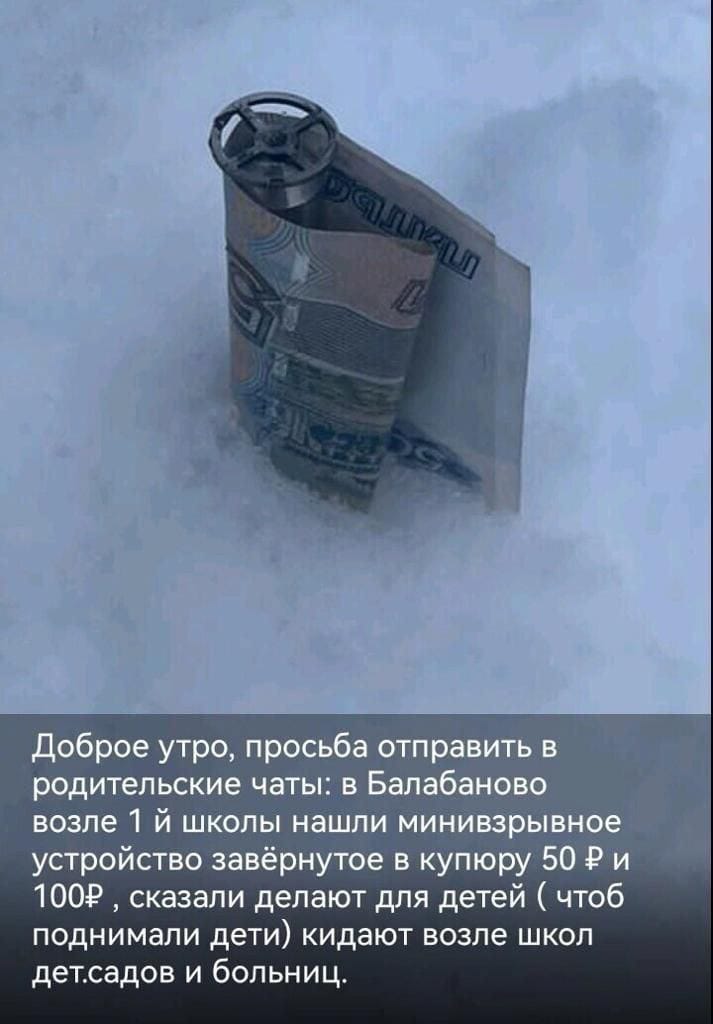
Although the authors of panicked reposts are confident that the attempted terrorist attack was stopped quite recently - at the end of November, a search on the Yandex Pictures service shows: nine months ago, at the end of February 2023, the same picture with a similar warning began to spread in parent chats of the Borovsky district of the Kaluga region, where, in fact, the city of Balabanovo is located.
On the evening of February 28, 2023 Borovsky district information center and public "News from Borovsky district“VKontakte denied the veracity of this message with reference to law enforcement agencies. It can be assumed that the authorities simply hid the truth and there was still an explosive device, but there is no information on the Internet and no reports from real witnesses that such a discovery even took place.
As is usually the case, the denials did little to reassure anyone, and the story continued to spread across the Internet. It changed during the process, and this is one of the important signs of a fake. To maintain a panicky mood, the authors of the reposts removed the school in Balabanov from the story and began to insert mentions of other places where messages were distributed, for example, the Ivanovo region and Saratov.

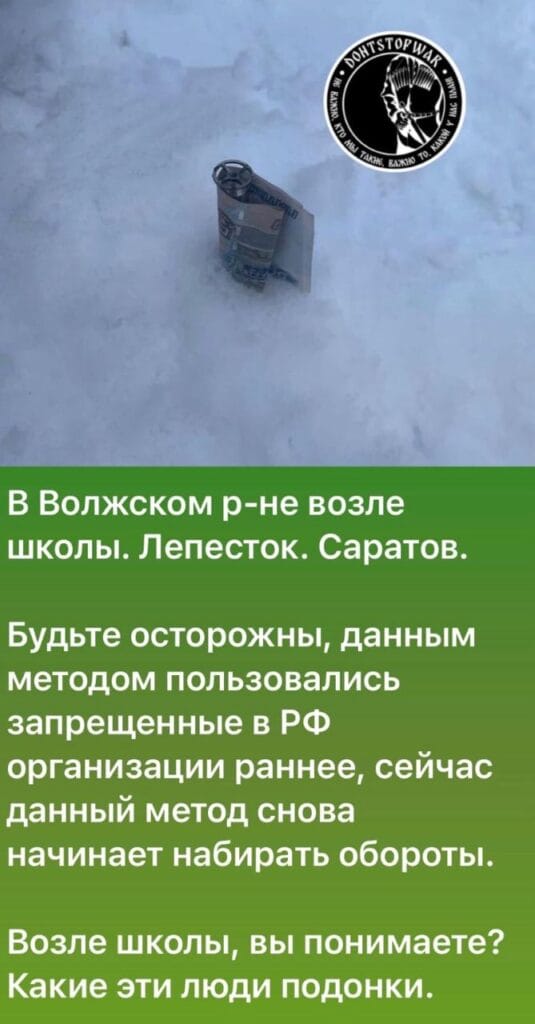
In addition, in the example of the Ivanovo region, another characteristic feature of fake news is noticeable - typification, that is, the transition of an event from the category of single events to the category of typical events. Read this: “On the territory of the Ivanovo region were discovered mini-explosives” - that is, we have a description of regular villainous actions, and not a one-time one, as in Balabanov’s story.
What about petal mines near schools?
Reports of explosive devices wrapped in banknotes allegedly being dropped near Russian schools are just one of several similar ones. In parent chats back in August 2022, a similar warning was distributed about “petal” mines that Ukrainian saboteurs allegedly scattered near educational institutions. Such posts arose against the backdrop of a large number of publications by “military correspondents” about “petal” mines, which were allegedly scattered by the Ukrainian military in the self-proclaimed DPR.
August 17–18 last year shelling Belgorod region from Ukraine, and at the same time in parent chats in this region passes a wave of reports of petal mines near schools. By words Regional Governor Vyacheslav Gladkov, such shells were found on the territory of the Shebekinsky District. There is no independent confirmation of this information.
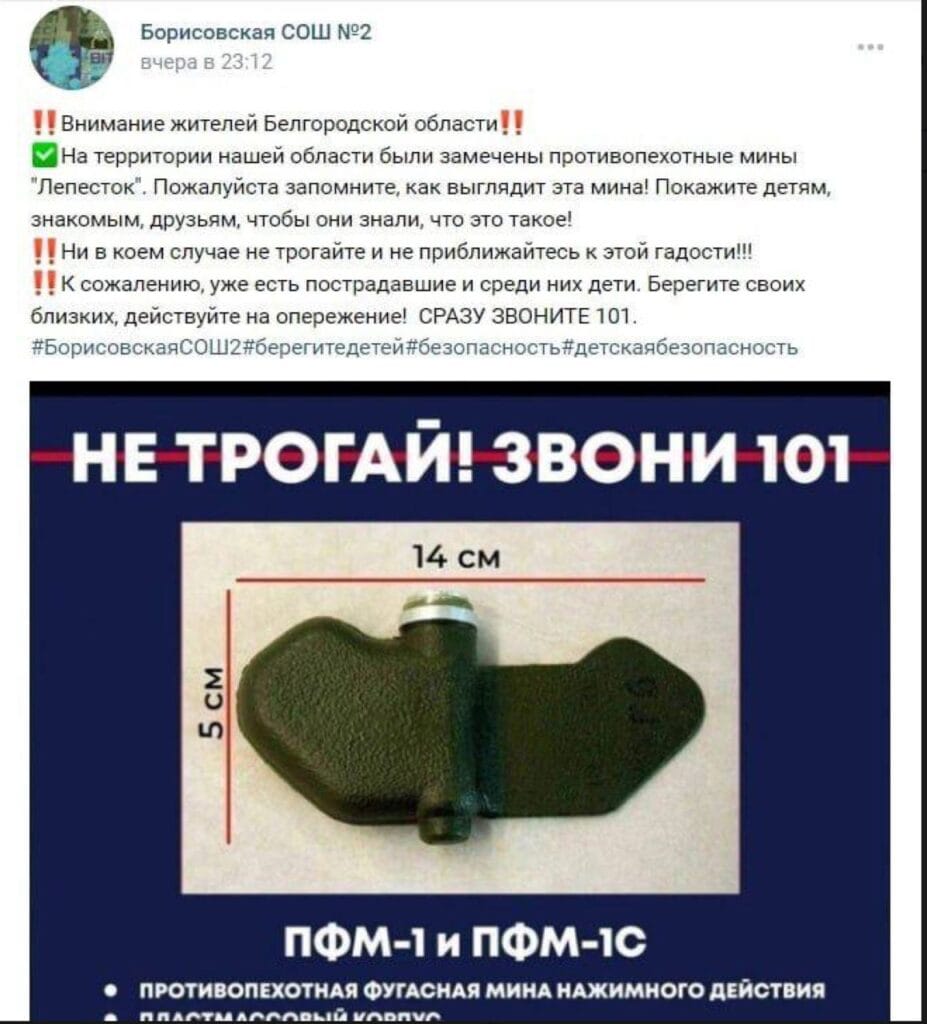
On August 18, after the shelling of Shebekin and panic messages about “petals” near schools, a screenshot of a message appears in one of the messengers; the author is identified as a certain Marina Mishchenko. In the photo the mine is already small and round. Subsequently, the screenshot was cropped, the sender’s name disappeared, and the picture began to be distributed in other regions of Russia.

Why did the mine become different? Because this photo has nothing to do with either the Belgorod region or the Russian invasion of Ukraine. Photo taken from published in 2010 demining manuals, and before us is the Italian anti-personnel high-explosive push-on mine SB33 Jane's Mines and Mine Clearance 1999-00. Even the hand in both photos is the same.

Why do you need to do such manipulations? Because you need to convince everyone of the great danger for children, and a photo with a mine on your hand is better than a photo of some kind of “petal”. It looks smaller and more dangerous, and could be mistaken for an earphone or a flattened ball. Therefore, the well-wisher who was the first to use this photograph, apparently, acted in the logic of “plausibility is better than the truth” - in such panic warnings, it is not the truth that is sold and conveyed well, but what is more effective in frightening.
Did your hands get torn off by bombs hidden in your passport? to a passerby in Voronezh and an ensign in Kursk?
Publications on social networks about mines near Russian schools are a kind of reincarnation of a broader story that spread on social networks more than a year ago. Then Internet users said that Ukrainian saboteurs began to disguise explosive devices as toys, balls, mobile phones, tablets and documents. One of these texts talked about a terrorist attack in Kursk, where a certain warrant officer allegedly lost his hand after picking up a booby-trapped passport. In a similar story from Voronezh, the victim was allegedly a simple passer-by.

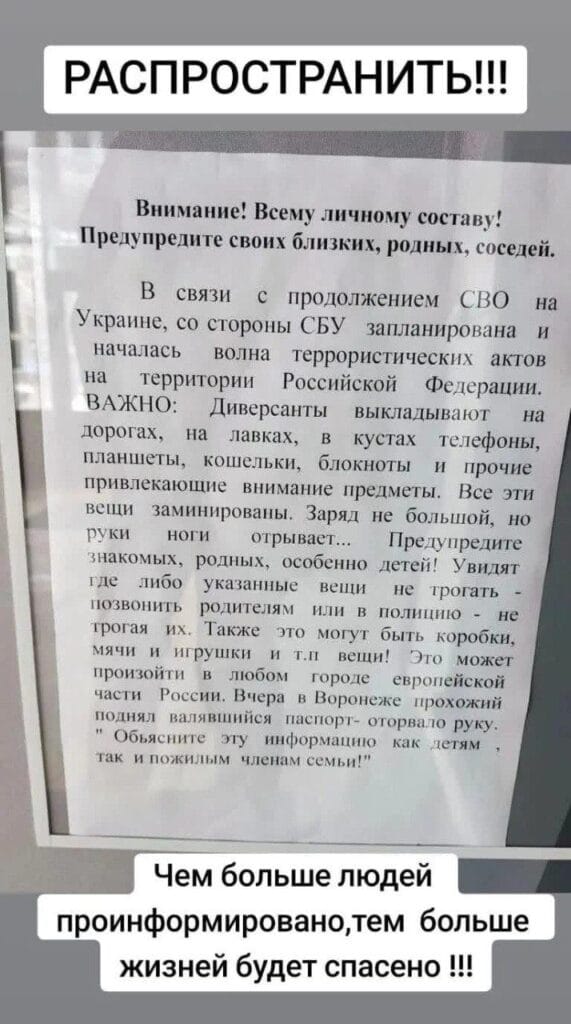
The Kursk version is the earliest; it appeared on social networks in southern Russia in May 2022. This story is relatively emotional and illiterate; it is probably intended for internal use (“we have one warrant officer”). The mention of the victim's rank suggests that the text originally appeared in a military chat. On May 12, a resident of Krasnodar posted it on her VKontakte page.
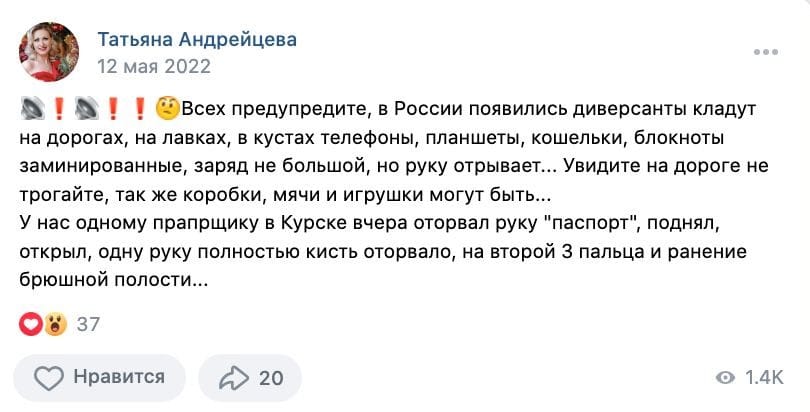
And on August 25, more than three months later, an edited “Voronezh” version appears in Odnoklassniki (unfortunately, all the first publications are no longer available). It is widely distributed throughout the regions of the Russian Federation, and sometimes the text is presented as message Unified duty dispatch service of Voronezh. There is no confirmation of these terrorist attacks (and this can hardly be kept silent).
Such stories - is this a mass phenomenon?
The above stories are not just fake but also very popular news. It is almost impossible to track how many times they were sent in WhatsApp and Viber messengers, where the main flow of such communications takes place. However, if messenger users encounter something frightening, then some of them will definitely share the information on social networks. People who want to draw attention to an issue begin to repost information, and the popularity of these publications can be assessed using Social Media Listening services.
The Medialogy program, which was loaded with keywords for all four stories, shows how 211,000 “visible” shares of these rumors spread on social networks. However, absolute numbers do not matter much here. It is more important to understand when stories about Ukrainian saboteurs were in demand. This is the end of summer and autumn of 2022 (when mobilization was first actively discussed in the Russian Federation and then announced), then in February-March and, finally, December 2023. More than 75% of users who reposted information about disguised mines and bombs are women, which is also understandable, because in Russia they often take it upon themselves to warn about everyday dangers associated with children.
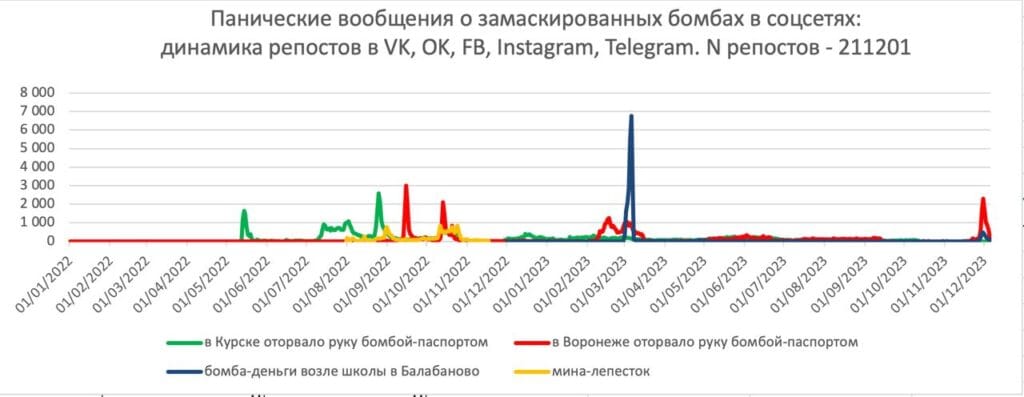
It is significant that the screenshots discussed above never contain dates. Therefore, when a parent chat participant receives a message like this, it seems to him that this is absolutely fresh and relevant information. Its constant spread creates a panic background and a strong feeling that the enemies are already nearby, they are approaching our children. For people who support Russia's military action against Ukraine, such stories are an argument for why the aggression must continue. As a result, waves of such panic mailings flare up again and again.
Bombs in the form of toys - a military horror story?
Stories about bombs in the form of toys or everyday objects are not new. During the Afghan War, the USSR and the USA accused each other in use such shells, but the authenticity of this has not been confirmed. Some experts questioned the existence of such bombs aimed specifically at Afghan children.
Nevertheless, the story of toy bombs has become a historical myth and is now actively used in publications about a variety of wars. So, in May 2020, RIA Novosti released a large article “Nazi atrocities near Leningrad: explosives in toys and poison for the sick,” which directly stated that Finnish pilots bombed the Leningrad region with bombs in the form of toys:
Not content with shelling and bombing from the air, the Finnish scoundrels used forms of villainous atrocities in the form of dropping children's toys from planes, which were filled with explosives, and at the moment when the children picked up these toys, explosions occurred, as a result of which the children died or were injured, remaining crippled.
The article, the author claims, is based on declassified documents from the archives of the FSB of the Russian Federation, and scans of some of them are even presented in the material. However, the document from which the quote about toy bombs was allegedly taken is not presented in the text, nor is there a link to it. It is possible that the journalist made up this story based on later rumors about the Afghan war.
***
Thus, all panic reports about bombs scattered by saboteurs on the streets of Russian cities and disguised as everyday objects or covered with money are not confirmed. There are no witnesses who saw this, there are no reports from the authorities and reports from journalists about terrorist attacks that occurred or were prevented. Warning texts have been circulating on the Internet for more than a year, and their details are constantly changing (for example, the same photograph can be presented as taken in different cities). In at least one case, a picture from a 2010 military manual was used as a photo of a bomb near a Russian school.
Cover photo: Wikimedia Commons
- V. Aksenov. War of patriotisms. Propaganda and mass sentiment in Russia during the collapse of the empire
- A. Arkhipova, A. Kirzyuk. Dangerous Soviet things: urban legends and fears in the USSR
- J. Hayward. Myths & Legends of the First World War
If you find a spelling or grammatical error, please let us know by highlighting the error text and clicking Ctrl+Enter.






